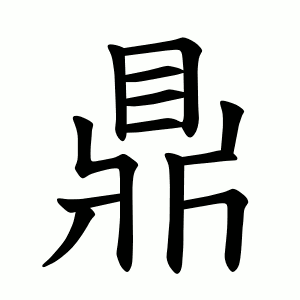鼎
- ding, cauldron;
- tripod pot;
Ancient large, three - legged bronze cauldron for cooking or sacrificial rituals
Etymology
It is a pictograph modeled after the shape of a three-legged cauldron with two handles, known as a samjokjeong (三足鼎).
Though it contains the component 目 (eye), it is not related to "eye" in meaning or origin.
The 鼎 refers to an ancient cooking vessel used in China, typically for boiling food, especially meat.
It played an important role in rituals, being used to boil sacrificial offerings during ceremonies.
In ancient China, boiling meat was the common cooking method, which made the tripod cauldron a vital kitchen tool as well as a sacred ritual item.
Furthermore, the 鼎 came to symbolize royal authority in ancient Chinese dynasties.
According to legend, Yu the Great, founder of the Xia dynasty, cast nine cauldrons (九鼎) using bronze collected from across the realm. These cauldrons became a symbol of kingship, passed down through subsequent dynasties such as Shang (商) and Zhou (周) after conquering their predecessors.
Usage in Korean
When used as a radical, 鼎 conveys meanings related to cauldrons, cooking, or ritual vessels.
Examples of characters using this radical:
鼐 (가마솥 내, large ceremonial cauldron)
鼏 (소댕 멱, small tripod pot)
䵼 (익힐 상, to cook/boil)
- 月山女一中 (BUVML)
- ⿶ 𤕰 目
